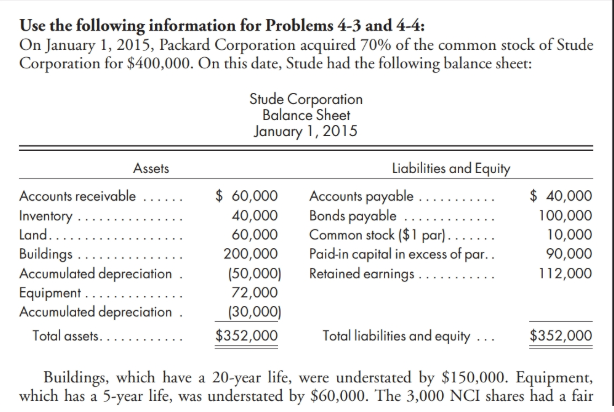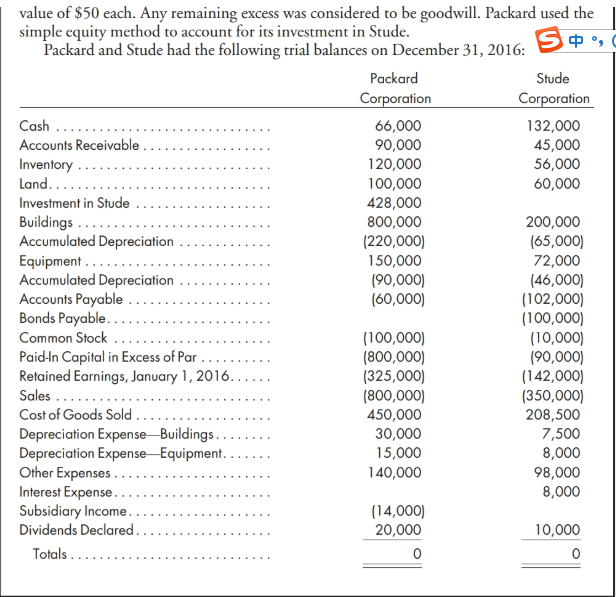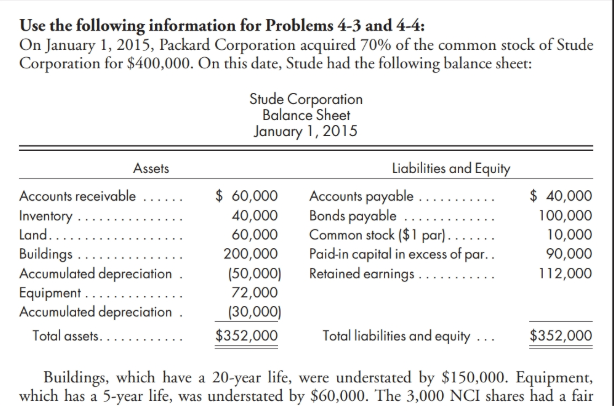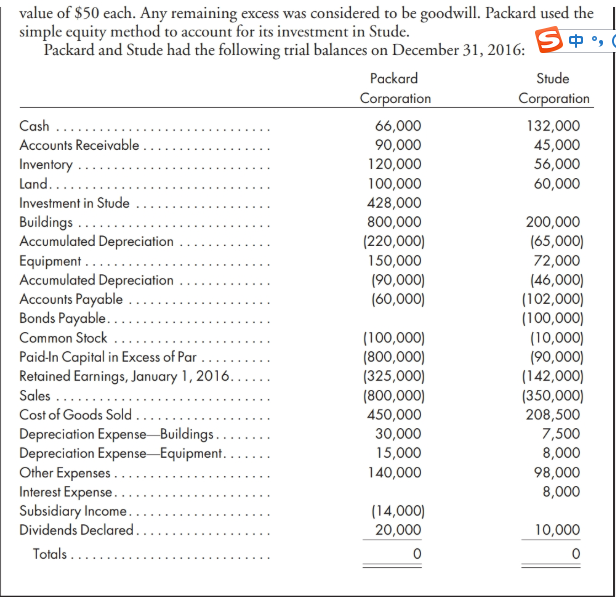


Problem 4-3 (10 2) 70%, equity, beginning and ending inventory, subsidiary seller. Refer to the preceding facts for Packard's acquisition of Stude common stock. On Jan- uary 1, 2016, Packard held merchandise acquired from Stude for $10,000. This beginning inventory had an applicable gross profit of 25%. During 2016, Stude sold $40,000 worth of merchandise to Packard. Packard held $6,000 of this merchandise at December 31, 2016. This ending inventory had an applicable gross profit of 30%. Packard owed Stude $11,000 on December 31 as a result of these intercompany sales.Use the following information for Problems 4-3 and 4-4: On January 1, 2015, Packard Corporation acquired 70% of the common stock of Stude Corporation for $400,000. On this date, Stude had the following balance sheet: Stude Corporation Balance Sheet January 1, 2015 Assets Liabilities and Equity Accounts receivable . . . . $ 60,000 Accounts payable . . . . . . . . . .. $ 40,000 Inventory . . . . . . 40,000 Bonds payable . . . . . . . . . 100,000 Land .. . .. . . . 60,000 Common stock ($ 1 par) . . . . . . . 10,000 Buildings . . . 200,000 Paid-in capital in excess of par. . 90,000 Accumulated depreciation . (50,000) Retained earnings . . . . . . . . . . . 112,000 Equipment . . . . . . . . . . . 72,000 Accumulated depreciation . (30,000 Total assets. . . . . . . . $352,000 Total liabilities and equity . . . $352,000 Buildings, which have a 20-year life, were understated by $150,000. Equipment, which has a 5-year life, was understated by $60,000. The 3,000 NCI shares had a fairvalue of $50 each. Any remaining excess was considered to be goodwill. Packard used the simple equity method to account for its investment in Stude. Packard and Stude had the following trial balances on December 31, 2016: Packard Stude Corporation Corporation Cash . . . . 66,000 132,000 Accounts Receivable . 90,000 45,000 Inventory . . 120,000 56,000 Land. . . . . . . 100,000 60,000 Investment in Stude 428,000 Buildings . . . . . . . . . . . . . . . . . . . . . . .. . 800,000 200,000 Accumulated Depreciation . . . . . . . . . . (220,000) (65,000) Equipment .. 150,000 72,000 Accumulated Depreciation . . . . . . . . . . . (90,000) (46,000) Accounts Payable (60,000) (102,000) Bonds Payable. . . (100,000) Common Stock . . (100,000) (10,000) Paid-In Capital in Excess of Par . . . . . . . . . . (800,000) (90,000) Retained Earnings, January 1, 2016. . . .. . (325,000) (142,000) Sales . . . . . . . (800,000) (350,000) Cost of Goods Sold . . . . . . . . . . . . . . . .. 450,000 208,500 Depreciation Expense-Buildings . . . . . . . . 30,000 7,500 Depreciation Expense-Equipment. . . .. .. 15,000 8,000 Other Expenses . . 140,000 98,000 Interest Expense. . . . . . 8,000 Subsidiary Income. . . . . . (14,000) Dividends Declared . 20,000 10,000 Totals .Cost Method Worksheet Trial Balance Eliminations Control. NCI Control Control Packard Stude Dr Cr. Net Inc. R.E. Bal. Sht. Investment in Stude 400,000 Patent Other Assets (net of liabilities) Common Stock - Packard Retained Earnings - Packard Common Stock - Stude Retained Earnings - Stude Revenue Expenses Patent Amortization Subsidiary (Dividend) Income Dividends Declared Consolidated Net Income To NCI (see distribution schedule) Balance to Controlling Interest (see distribution schedule) Total NCI Retained Earnings, Controlling Interest













